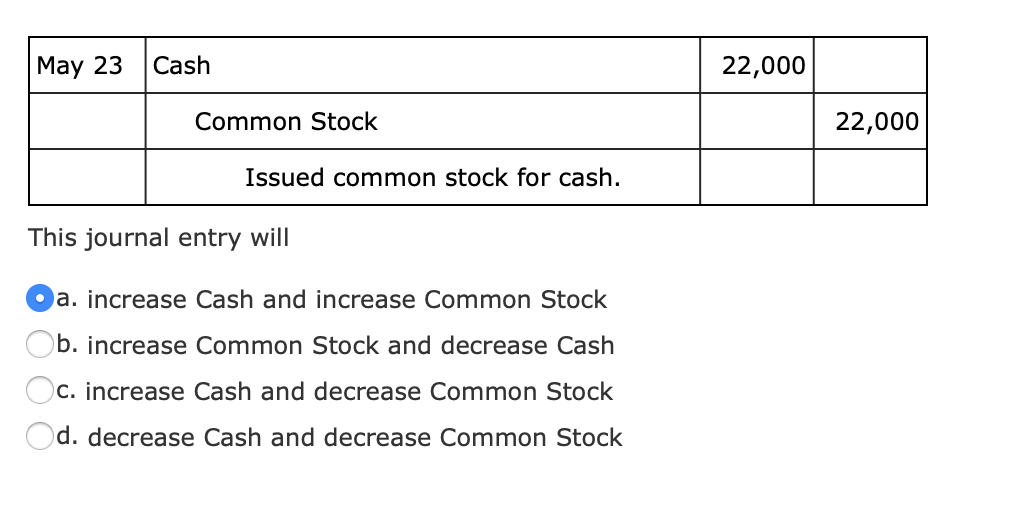
So there is a complication to deal with, but with our comprehensive guide, preparing a journal entry for issue of common stock is very straightforward. For example, we issue 5,000 shares of common stock in our corporation to acquire a plot of land. These 1,000 shares of the common stock have a par value of $1 per share and a market value of $10 per share as of the issuing date. The terms above may be better understood with an analogy to a credit card. If you are approved for a credit card, the terms will include a credit limit, such as $5,000, which is the maximum you are allowed to charge on the card. This is similar to “shares authorized,” the maximum number of shares a company is allowed to issue.
How to Account for Common Stock Issued
Common Stock or Common Share is the company equity instrument that represents corporation ownership. The company listed on the stock exchange and sell the ownership to the investors to raise the capital. The company wants to raise cash to pay off debt, expand the operation, acquire other company and support daily activities.

Issuing common stock for service example
When a company issues new stock for cash, assets increase with adebit, and equity accounts increase with a credit. To illustrate,assume that La Cantina issues 8,000 shares of common stock toinvestors on January 1 for cash, with the investors paying cash of$21.50 per share. When a company issues stock for property or services, thecompany increases the respective asset account with a debit and therespective equity accounts with credits. The company plans to issue most of the shares in exchange forcash, and other shares in exchange for kitchen equipment providedto the corporation by one of the new investors. Two common accountsin the equity section of the balance sheet are used when issuingstock—Common Stock and Additional Paid-in Capital from CommonStock.
Issuance of common stock at price higher than par value
Common stock is a financial instrument that represents the ownership of a company. In accounting, this term describes the total finance received from a company’s shareholders over the years. Companies may also refer to it as ordinary stock, which represents the same concept.
Journal Entries for Deferred Tax Assets and Liabilities
However, Kellogg communicates additional information about its common stock such as the number of authorized and issued shares as well as its par value. That seems the logical first step in analyzing the information provided by a company about its capital shares. However, for today, we’ll be assuming the Board at ABC Ltd has decided to repurchase Kevin’s shares as he wants to cash in and go and play golf and see the world.
Types of Common Stock Transactions
- This number is important because it serves as the basis for dividend payments as well as any votes taken of the stockholders.
- As mentioned, this process includes calculating the par value of the underlying shares issued.
- The legal capital in this example would then be equal to $ 250,000.
- And yes, I do fly with people who don’t care much for aircraft!
- When a corporation issues common stock at par value, the amount of cash or non-cash assets received equal to the value of the common stock.
In this case, the debit side of the journal entry will be the expense amounting to the cost or the fair value of the service that needs to be charged to the income statement instead. However, if the share price is not available on the taxes on sweepstakes prizes worth less than $600 market, the cost of the non-cash asset will be used instead. On the other hand, if the stock price equal to the par value, only cash and common stock on the balance sheet will be affected as the result of the issuance of the stock.
Stock may be issued for assets other than cash, such as services rendered, land, equipment, vehicles, accounts receivable, and inventory. This is more common in small corporations than in larger ones. The journal entries are similar to those for issuing stock for cash. In this case, the value of either the stock or the asset must be known. The assumption is that both the asset and the stock have the same value.
According to the information provided, Kellogg has acquired nearly thirty-seven million treasury shares. Although not mentioned directly, Kellogg now has only 382 million shares of common stock outstanding in the hands of the stockholders (419 million issued less 37 million treasury shares). This number is important because it serves as the basis for dividend payments as well as any votes taken of the stockholders. The journal entry for issuing the common stock for cash will increase both total assets and total equity on the balance sheet. It is useful to note that when the corporation has more than one type of stock, the additional paid-in capital account above should be broken down to identify which type of stock it belongs to.
Common Stock consists of the par value of all shares ofcommon stock issued. Additional paid-in capitalfrom common stock consists of the excess of the proceeds receivedfrom the issuance of the stock over the stock’s par value. When acompany has more than one class of stock, it usually keeps aseparate additional paid-in capital account for each class.